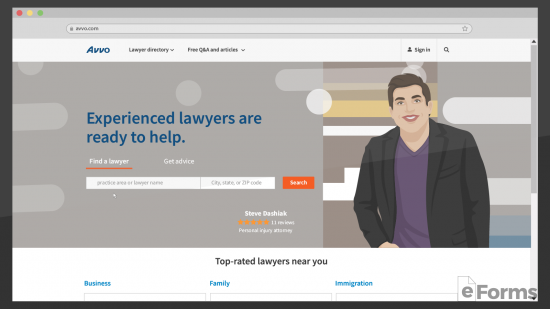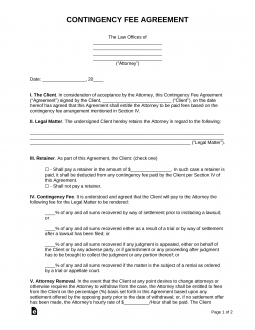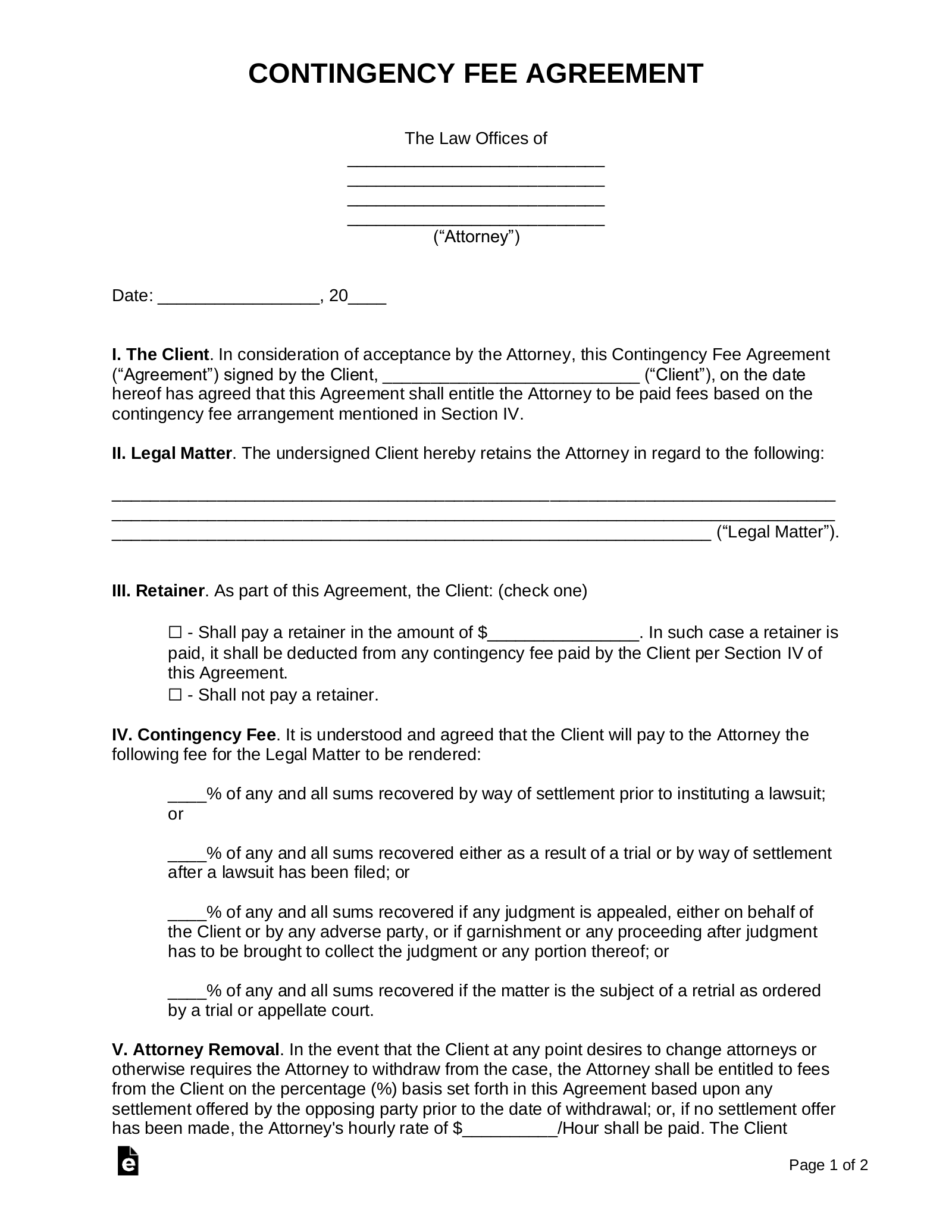Updated August 23, 2023
A contingency or contingent agreement is a contract between a client and an attorney that is paid based on the performance of their services. The attorney, instead of being paid by the hour, will receive a portion of the total amount of funds collected from the other party after a settlement or judgment. This is often due to 2 factors, 1) The client does not have the funds to pay the attorney by the hour and 2) The attorney’s portion of the proceeds would exceed the amount if they were paid by the hour.
Table of Contents |
What is a Contingency Fee?
A contingency fee is the attorney’s compensation that is only owed if funds are received by the other party. If the attorney providing the service is not successful in their obligations then the client is not required to pay the contingency fee or any other payment.
Contingency Fee Example
An attorney may accept a case from a client in return for a percentage (%) of the total proceeds ($) received by the other party. In such a case, the client is not obligated to pay by the hour or other fees. The only cost will be if the attorney wins the case and funds are received.
Standard (Average) Contingency Fee
The American Bar Association (ABA) states the following:
In a contingent fee arrangement, the lawyer agrees to accept a fixed percentage (often one-third (1/3)) of the recovery, which is the amount finally paid to the client. If you win the case, the lawyer’s fee comes out of the money awarded to you. If you lose, neither you nor the lawyer will get any money, but you will not be required to pay your attorney for the work done on the case.
Source: American Bar Association
Although, most attorneys have a scaled percentage depending on how much work they have to put into the case.
An example is as follows:
- 25% of proceeds collected before a lawsuit is filed;
- 33.3% if the case is settled after a lawsuit is filed;
- 40% if the case is settled after the first (1st) trial date; and
- 50% if the case goes to trial and a judgment is administered.
How Does a Contingency Fee Work? (5 steps)
- Research Attorneys in Your Area
- Meet with Qualified Attorneys
- Receive Offers
- Choose the Attorney for the Case
- Create the Contingency Agreement
The process of creating a contingency agreement depends on the attorney and the legal case presented. The attorney will have to judge the hours needed on the case, the chance of winning, and the total amount that can be feasibly collected before agreeing to work with the client.
1. Research Attorneys in Your Area

The best way to find an attorney is to speak with colleagues, friends, and family and ask who is the best lawyer for your needs. In addition, looking up recent cases to see who is currently active in the industry is a great option.
If there is no one that comes to mind, checking online resources is the next best solution to find the ratings and reviews of qualified attorneys. Use the following online resources:
2. Meet with Qualified Attorneys

After narrowing the attorney selection down to a few qualified persons it’s now time to meet and discuss your case. Most attorneys will offer free consultation on the first (1st) meeting to discuss your case and decide whether or not it makes for them to take it on.
In addition, some attorney-client relationships work better than others, therefore be sure that you and the attorney are on the “same page” when it comes to the strategy against the Defendant.
3. Receive Offers

After meeting with the qualified attorneys they will give their rates for the case based on its chance of winning in court and who is the Defendant. For example, if the Defendant is an insurance company the attorney knows that the payout will be significantly higher than if the Defendant is your neighbor who is unemployed.
4. Choose the Attorney for the Case

After reviewing the offers and each strategy it is time to choose the attorney that is right for the case. The selected attorney will most likely request to meet and discuss the next course of action. Depending on the type of arrangement made, a retainer payment may be requested to get working on the matter.
5. Create the Contingency Agreement

Download: PDF, Microsoft Word (.docx), Open Document Text (.odt)
A contingency agreement is especially popular with legal matters related to personal injury, medical malpractice, property damage, or any case where damages can be proven.
Sample Contingency Fee Agreement
CONTINGENCY FEE AGREEMENT
The Law Offices of
[ATTORNEY NAMES]
(“Attorney”)
Date: [DATE]
I. The Client. In consideration of acceptance by the Attorney, this Contingency Fee Agreement (“Agreement”) signed by the Client, [CLIENT’S NAME] (“Client”), on the date hereof has agreed that this Agreement shall entitle the Attorney to be paid fees based on the contingency fee arrangement mentioned in Section IV.
II. Legal Matter. The undersigned Client hereby retains the Attorney in regard to the following: [LIST SERVICES] (“Legal Matter”).
III. Retainer. As part of this Agreement, the Client: (check one)
☐ – Shall pay a retainer in the amount of $[AMOUNT]. In such case a retainer is paid, it shall be deducted from any contingency fee paid by the Client per Section IV of this Agreement.
☐ – Shall not pay a retainer.
IV. Contingency Fee. It is understood and agreed that the Client will pay to the Attorney the following fee for the Legal Matter to be rendered:
[#]% of any and all sums recovered by way of settlement prior to instituting a lawsuit; or
[#]% of any and all sums recovered either as a result of a trial or by way of settlement after a lawsuit has been filed; or
[#]% of any and all sums recovered if any judgment is appealed, either on behalf of the Client or by any adverse party, or if garnishment or any proceeding after judgment has to be brought to collect the judgment or any portion thereof; or
[#]% of any and all sums recovered if the matter is the subject of a retrial as ordered by a trial or appellate court.
V. Attorney Removal. In the event that the Client at any point desires to change attorneys or otherwise requires the Attorney to withdraw from the case, the Attorney shall be entitled to fees from the Client on the percentage (%) basis set forth in this Agreement based upon any settlement offered by the opposing party prior to the date of withdrawal; or, if no settlement offer has been made, the Attorney’s hourly rate of $[#]/Hour shall be paid. The Client directs the Attorney not to withdraw from this matter unless he has been paid the larger of the two (2) possible fees or arrangements for the said payment has been made to their satisfaction.
VI. Lien. The Client agrees to give the Attorney a lien on the claims or causes of action and on a sum recovered by way of settlement and on any judgment that may be recovered thereon to the extent of the amounts herein provided as the Attorney’s fees and other fees, charges, and expenses incurred. It is further agreed that the Attorney shall have all general, possessory, or retaining liens, and all special or charging liens known to the common law or available under law.
VII. Client’s Decision. The Client has the ultimate right to decide whether or not an offer of settlement is satisfactory. It is agreed that the primary purpose the Client has agreed to the services of the Attorney is that the Client believes the Attorney’s background and experience offer the best chance to reach a fair and equitable settlement. It is therefore agreed that if, at any time, the Client and the Attorney cannot agree as to the settlement of the case, then in that event, the Attorney may withdraw from the case and will be paid their fees to the date of withdrawal as is provided herein. Said fees shall be a lien on the case and any party at interest may be so informed.
VIII. Attorney’s Recommendation. In the event a settlement proposal is made to the Client with the affirmative recommendation of the Attorney, the Attorney shall have the right, if such settlement proposal is rejected by the Client, to be paid for all services rendered by the Attorney, calculated on the basis of actual work hours expended at the hourly rate mentioned in Section V and for all other fees, charges, and expenses incurred.
IX. Client Notification. The Attorney agrees to notify the Client whenever an offer of settlement or compromise is received by the Attorney, and to inform the Client of the amount of that offer, and the recommendation of the Attorney as to the acceptability thereof. In addition, the Client agrees to make no compromise or settlement in the matter without the approval of the Attorney. The Client agrees to notify the Attorney whenever an offer of settlement or compromise is received by the Client, and to inform the Attorney of the amount and the terms of any such offer.
X. Client Authorization. The Client hereby authorizes the Attorney to thoroughly investigate the facts and laws relative to the Legal Matter. Upon the conclusion of such investigation, the Attorney shall have the discretionary right to determine that it is not feasible to pursue the Legal Matter, and upon notification to the Client of such determination the Attorney shall be entitled to withdraw from any further representation of the Client pursuant to this Agreement. In such an event, no legal fees shall be payable to the Attorney, but the Client agrees to promptly pay the Attorney for all other fees, charges, and expenses incurred pursuant to the above prior to the date of such withdrawal.
Client’s Signature ________________________ Date ____________
Print Name _____________________________
Attorney’s Signature ________________________
Print Name _____________________________
How to Write (Fill-In)
Download: PDF, MS Word (.docx), OpenDocument
Step 1 – Acquire Your Copy Of The Contingency Agreement Through This Site
Once you are ready to develop and execute paperwork framed around the terms of an agreed-upon attorney’s contingency payment(s), select the “PDF,” “MS Word (.docx),” or “OpenDocument” text links above this statement.
Step 2 – Identify The Attorney Or Law Firm Accepting This Agreement
Gather your references for this paperwork then open the file you downloaded with the appropriate software. Once you’ve done so, locate the words “The Law Offices Of” at the top of the page. The blank lines placed below this phrase expect the legal name and business address of the Law Firm or the Attorney entering this contract. 
Step 3 – Set A Specific Date To Apply To This Paperwork
It will be important to attach a specific “Date” for this agreement. This will give a point of reference and solidify the agreement’s timeline. To this effect, find the two lines attached to the word “Date.” The calendar month, day then the two-digit year should be produced on these formatted lines ![]()
Step 4 – Introduce The Contingency Client
The first item or article of this document provides the language needed to attach the Client to this agreement however, you must supplement this wording with the full name of the Business Entity or Private Party that will hire the Attorney named above on a contingency basis. Furnish the name of this Client on the blank line presented in the first article (labeled “I. Client”). 
Step 5 – Discuss The Concerned Legal Matter
The second article designated as “II. Legal Matter,” will seek a reasonably adequate description of the case the Attorney handle. This, of course, is with the understanding that he or she must represent the Client successfully to obtain payment. The blank lines in this article allow a direct report of this description. If more room is required, you may add more space, or you may record the full title of an attachment with the appropriate content. 
Step 6 – Document The Agreed Upon Retainer Status
Some legal procedures or cases may go on for a significant amount of time. To offset the costs of operation while the Attorney represents the Client, a certain amount of money may be paid as a retainer. This is a sum released to the Attorney in advance and will be deducted from the final (contingency) payment. Regardless of whether a retainer fee is required, you must locate and tend to article “III. Retainer” to indicate the status of this option. Thus, if a retainer fee will be paid as per this agreement, you must mark the first checkbox in this section (“III. Retainer”), then proceed through the corresponding statement to document the dollar amount of the retainer on the blank line attached to the dollar sign.  If no retainer is required, then mark the checkbox labeled “Shall Not Pay A Retainer”
If no retainer is required, then mark the checkbox labeled “Shall Not Pay A Retainer”![]()
Step 7 – Define The Contingency Fee
Once the legal services have been provided to the success of the Client, the Attorney will be entitled to collect the promised contingency payment. The contingency payment amount must be solidified, and this will be accomplished by defining it as a percentage in article “IV. Contingency Fee.” Several statements with the wording necessary to apply such a percentage payment have been supplied for your use. If the Attorney reaches a settlement with the opposing party prior to any lawsuit then record the percentage of the settlement earnings that shall be paid to the Attorney on the blank space attached to the percent sign. If the Attorney will earn a percentage “Of Any And All Sums Recovered” resulting from a trial or the settlement of a lawsuit in progress (post-filing) then record the percentage earned on the blank space attached to the second statement.
If the Attorney will earn a percentage “Of Any And All Sums Recovered” resulting from a trial or the settlement of a lawsuit in progress (post-filing) then record the percentage earned on the blank space attached to the second statement.![]() Should the Attorney be entitled to a percentage of funds that were awarded or recovered as a result of an appeal (regardless of the which party filed this appeal) or a percentage of any garnishments resulting from judgment, then document the contingency percentage on the blank space corresponding to the third statement.
Should the Attorney be entitled to a percentage of funds that were awarded or recovered as a result of an appeal (regardless of the which party filed this appeal) or a percentage of any garnishments resulting from judgment, then document the contingency percentage on the blank space corresponding to the third statement. ![]() If the courts rule that the subject warrants a retrial or that one must be conducted by an appellate court and the Attorney will gain a contingency payment from any sum paid to the Client as a result, then fill in the percentage defining this expected payment on the fourth blank space of this section.
If the courts rule that the subject warrants a retrial or that one must be conducted by an appellate court and the Attorney will gain a contingency payment from any sum paid to the Client as a result, then fill in the percentage defining this expected payment on the fourth blank space of this section.![]()
Step 8 – Address The Topic Of Termination
The language in the fifth article will safeguard the Attorney’s interest should the Client, for whatever reason, terminate or no longer require the services of the Attorney. If the Attorney has devoted a great amount of time to the Client’s case this could have severe repercussions on his or her ability to continue operations. Thus, use the blank line in “V. Attorney Removal” to indicate how much money the Attorney will be paid for every one hour of work on the Client’s case should the Client determine the Attorney’s services are no longer required. 
Step 9 – The Attorney And Contingency Client Must Combine Signatures
This paperwork can only hold the entities we have identified earlier obligated to its terms if both provide a valid signature after reading and approving the articles it contains. The first signature area devoted to this task is set for the Client. He or she must read every article of the completed agreement, sign his or her name on the “Client’s Signature” line, report the current “Date” immediately after signing (on the blank line to the right), then print his or her full name on the “Print Name” below.  The second and last signature area can only be satisfied with by the Attorney or a representative of the Law Firm entering this agreement. The Signature Party representing the Attorney or Law Firm must sign the “Attorney’s Signature” line then print his or her name on the space labeled “Print Name.”
The second and last signature area can only be satisfied with by the Attorney or a representative of the Law Firm entering this agreement. The Signature Party representing the Attorney or Law Firm must sign the “Attorney’s Signature” line then print his or her name on the space labeled “Print Name.” 


